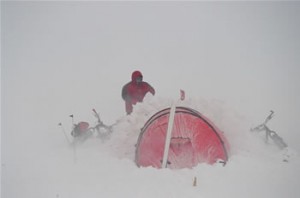Arctic Survival
Surviving in temperatures below -40 degrees Celsius depends on more than just staying warm. The physical properties of many substances change in low temperatures, and it is essential to prepare for these occurrences. Butane and propane, for example, cannot be used for cooking as they will remain in a liquid state. Plastic becomes brittle, grease becomes thick, friction of rubber diminishes, condensation in clothing dramatically increases, and potable water becomes scarce.
This section of the Adventurer’s Handbook provides information on how to survive in extreme cold conditions for extended periods of time.
Here are four tips to keep in mind as you prepare for your adventure.
- Living and traveling for extended periods in temperatures -40 degrees Celsius or colder is an experience far removed from the familiar. The experience of living in a conventional home in northern Alaska or Canada and spending a few hours a day in the cold is not the same as committing yourself for weeks to the Arctic winter and carrying all your own possessions.
- An important thing to consider is that dexterity will be vastly reduced. Most of the time you will be wearing bulky gloves, and anything that needs to be done – from setting up the tent to making repairs – must be done with this reduced dexterity. Additionally, some materials become much more brittle, and plastics are especially prone to breaking.
- Be sure to become very familiar with cold-weather routines before committing yourself to a long dangerous journey. Start out by taking short trips near civilization. One thing that quickly becomes apparent to Arctic explorers is just how tenuous survival can be. Mistakes add up quickly and death can occur in hours.
- Make sure you have redundant systems or the means to easily repair all essential gear. Go through drills for various disaster scenarios. If you have the knowledge, the practice, a calm head and don’t mind perpetually being uncomfortable, you are ready for Arctic journeying.

